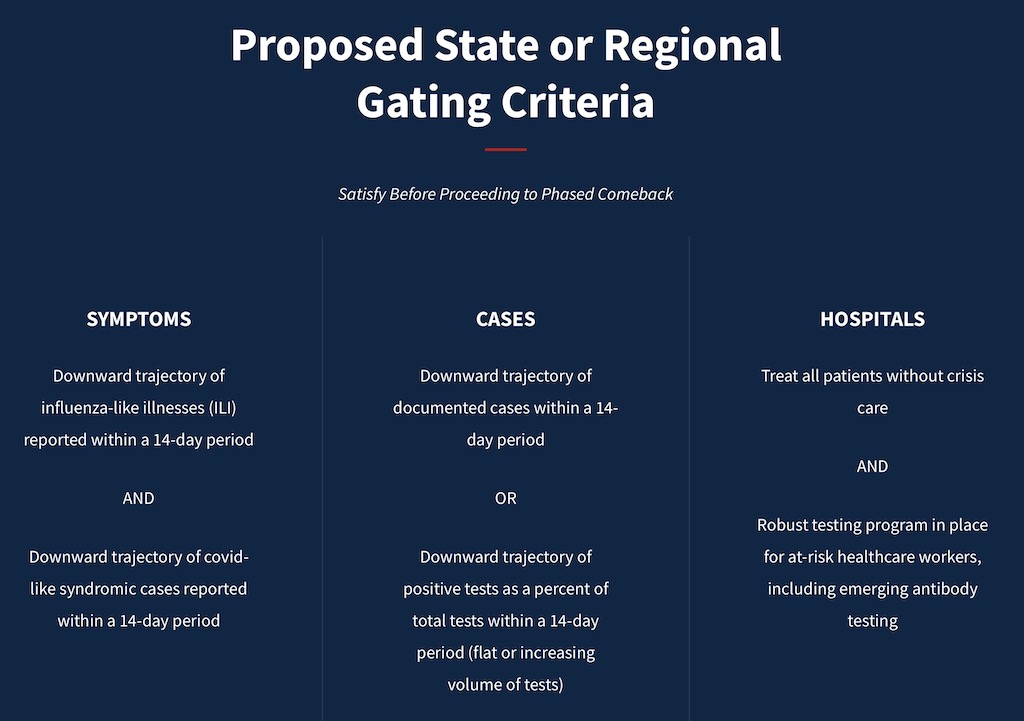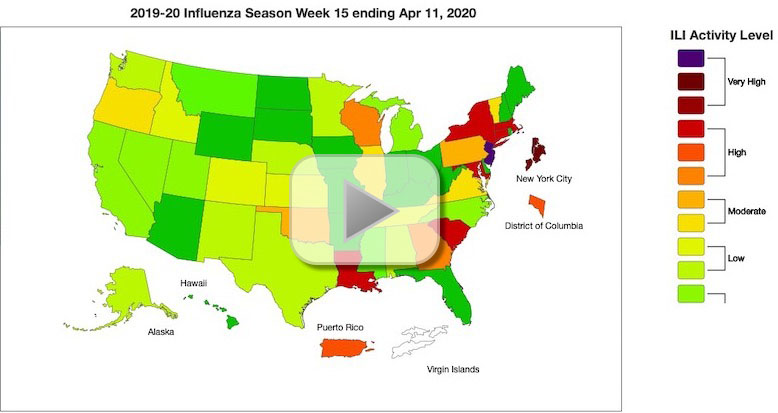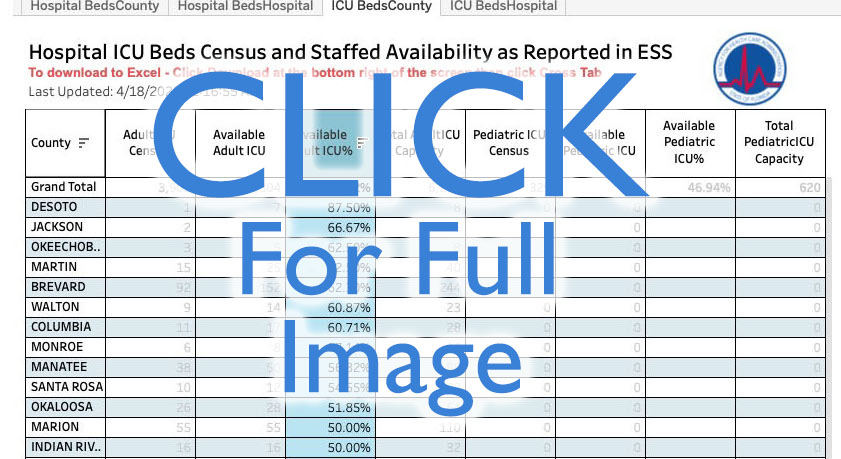Heard on social media regarding reopening the economy:
“If we open up the economy, people will die.”
“If we don’t open up the economy, people will die.”
Now what?
This is necessarily a long article. If you are looking for something quick that agrees with an agenda, move on. To answer the question “Does Florida meet the federal criteria to ‘Open Up America Again?'”, you have to understand the guidelines and their criteria for a “Phase One” reopening. Then, the data on Florida can be evaluated against the criteria. If you think “opening up” needs to include testing, you are in violent agreement with the guidelines.
Evaluating a state/region against the guidelines and its criteria is not a short endeavor. Below, I’ve tried to present the guidelines/criteria against the relevant data from our COVID-19 community tracker project. The intent is to put a fact-based stake in the ground on readiness of Florida without bias or preconceived conclusion. I’ve also included technical briefings from Dr Fauci, Dr Redfield, Dr Birx and Dr Giroir as the top scientists and officials with bloody knuckles from leading the federal response to the COVID-19 pandemic.

To open up again, you have to meet criteria for Symptoms, Cases and Hospitals PLUS demonstrate preparedness to implement the “Core State Preparedness Responsibilities” for testing, contact tracing, healthcare capacity and worker protection plans.
“If you think ‘opening up’ needs to include testing, you are in violent agreement with the guidelines”
What you need to know about “Opening Up America Again”
On April 16, the federal government issued guidelines to “Open Up America Again“. It’s a three phased strategy that allows states and “regional areas” (e.g. NY, NJ, CT) to reopen depending on their situation. However, before you can enter phase one, you have to meet certain criteria AND the state has to commit to “core responsibilities”. One of these is testing but testing is not the only responsibility. In the video below, the Director of the National Institute of Allergy and Infectious Diseases Dr Anthony Fauci gives a concise explanation of the testing aspect of the guidelines. If you skip the video, you are skipping what you need to know.
TOPICS COVERED IN VIDEO:
Two kinds of tests are required but testing isn’t enough. We need the multifaceted approach in the guidelines to manage and contain the virus.
The problems that occurred in the beginning and how they were fixed
Recent issues between having the capacity to do testing and providing access to it where the demand is
How testing has to change in each phase
More testing increases case counts
When you increase the number of daily tests, you increase the number of results. You can over test a population and under test a population. Public health experts say ideally, you want to test at least 30 people per 1000 population and if you are getting about 10% positive results, then you are doing enough testing. At the present time, Florida has the capacity to test 50-60 people per 1000. If you want to get smart on how the broken pre-pandemic CDC testing system was transformed in the past 6 weeks, watch the attached excerpt from the April 17 technical briefing by the Assistant Health Secretary on testing. It’s worth the 14 minutes. SPOILER ALERT: “It’s beyond the possibility to test everyone in the country every day. But it’s also a bad strategy.” – Adm. Brett Giroir MD
TOPICS COVERED IN VIDEO:
How testing capacity for COVID-19 is twice the volume in a month compared to HIV testing in a year
The role of high immediate tests and high volume tests
How the distribution of State public labs versus the US private sector, Academic labs capacity covers the entire country
The problems with swab availability and how scientific community developed the technology to use more readily available swabs and transport media
The science says the US has enough tests to go into Phase One
How you calculate the quantity of testing you need
Strategy for surveillance testing for asymptomatic carriers
“Opening Up America Again” guidelines in a nutshell
According to the guidelines, the ability to open up again is based on up-to-date data for the last 14 days plus the readiness of the state/county to perform adequate testing, contact tracing and to have adequate hospital availability. This “starting gate” to open up again makes sure a state/county is past its peak and has the ability to mitigate the risk of resurgence. It bears repeating that: you have to meet BOTH the criteria and the guidelines on testing and medical capacity. The phases define policies to protect the most vulnerable while simultaneously opening up the economy.
… you have to meet BOTH the criteria and the guideline’s on testing and medical capacity
The “gating” criteria that must be satisfied before proceeding to a phased comeback is shown in the figure below. According to the guidelines:
State and local officials may need to tailor the application of these criteria to local circumstances (e.g., metropolitan areas that have suffered severe COVID outbreaks, rural and suburban areas where outbreaks have not occurred or have been mild). Additionally, where appropriate, Governors should work on a regional basis to satisfy these criteria and to progress through the phases outlined below.
Whitehouse Guidelines for Opening Up America Again

The “Symptoms” criteria to open up again
The Centers for Disease Control and Prevention (CDC) surveillance system uses a nationwide “symptom reporting” system that is fed by testing labs, hospitals etc. It tracks many things but one important one is the reporting of influenza and covid-like symptoms. In order to go through the “Symptoms” gate for Phase One, a County/State/Region must pass two 14-day look-backs of case data regarding symptoms. This is the “Influenza Like Illness” (ILI) and “Covid-like Syndromic” (CVS) data often referred to in the COVID-19 Task Force briefings. If you want to get smart on the CDC surveillance capabilities, watch the 5-minute briefing by the CDC Director Dr. Robert Redfield.
TOPICS COVERED IN VIDEO:
How the CDC upper respiratory surveillance systems down to the county level indicates where the Corona virus is
The traditional public health approach to manage and contain outbreaks
State by state presence of CDC personnel
Does Florida meet the Symptoms criteria to open up?
Using data extracted from government sources and the BocaFirst Tracker, this is how Florida stacks up against the “symptoms” criteria. The criteria that must be met is shown in the blue bubble.

The “Cases” criteria to open up again
The Cases criteria is based on the daily new confirmed cases. Because the number of cases is based on the number of tests, the criteria specifies the necessary case trend and test volume. Passing the criteria requires satisfying one of two 14-day look-backs of COVID-19 case data. One is based on documented case data and the other is based on testing results given adequate volume.
Does Florida meet the Cases criteria to open up?
Using data collected from Floridadisaster.org the graphics below summarize how Florida stacks up against each “Cases” criteria. The criteria that must be met is shown in the blue bubble.

Meeting the “Hospitals” criteria to open up
This gate requires a state/county/region to treat all patients not requiring crisis care AND have a testing program for healthcare workers that includes antibody testing.
Meeting the hospital criteria requires state and county governments to implement the both types of testing and ensure its healthcare system has the capacity to handle both a resurgence and a surge if needed. While Florida has been one of the top 10 hit states in the country with its international airports, cruise terminals and winter destination for New Yorkers, it’s also been one that contained and mitigated the spread.

This can be seen in the CDC historical ILI data as Influenza B, Influenza A and then COVID-19 bloomed and receded to the point on where April 11 Florida had “Minimal” ILI activity. Here is an animation of all the states week by week. Keep an eye on Florida.

Does Florida meet the Hospitals criteria to open up?
According to Florida’s Agency for Health Care Administration’s data dashboard, as of April 18, hospital beds and ICU bed availability statewide is 37%. Hospitals in Miami-Dade, which has the most total cases in the state, reports 35% availability and Palm Beach with the 3rd highest reports 29% availability.

Meeting the “Hospitals” criteria is more than availability. It is also the state’s responsibility to ensure its healthcare system capacity can quickly supply personal protective equipment, critical medical equipment and have ICU capacity to handle a surge. It is also required to have a “robust” system in place for testing healthcare workers with both screening and antibody testing.
Core State Responsibilities to open up
The statewide “Stay at Home” order enacted April 1 will expire on April 30. In his April 17 briefing, Gov. Ron DeSantis, said he has initiated the effort to implement the necessary testing for hospitals but also so businesses have what they need to operate safely. As far as entering Phase One of reopening, the state must:
- Protect workers in critical industries
- Those living and working in high-risk areas (Senior care facilities …) must be protected
- Protect employees and users of mass transit
- Advise public on distancing and face covering protocols
- Monitor conditions and immediately take steps to mitigate
- Have the ability to setup screening symptomatic individuals
- Be able to trace contacts for COVID positive results
- Have the ability to test Syndromic/ILI indicated persons for COVID with contact tracing
- Ensure sentinel surveillance for asymptomatic cases (with contact tracing) for locations with older individuals, lower income, racial minorities and Native Americans.
States have multiple types of tests
Testing is a core part of being able to manage COVID-19 and protect Americans through the phases of Open Up America. In the space of 11 minutes, White House Coronavirus Response Coordinator Dr Deborah Birx explained the cocktail of tests that are in place, what each one does toward the goal and the level of preparedness of each state.
TOPICS COVERED IN VIDEO:
The three types of screening and antibody tests
Influenza Like Illness and COVID-like Syndromic surveillance
Specificity and sensitivity of antibody tests and when/where to use them
How an algorithm of tests is being built
Current US platform distribution throughout the US
How many tests per thousand you need and how many each state has
The Federal Government needs ensure to states and labs utilize the full US testing capacity during Phase One
Screening test will never be able to test 3.5M people every day but there might be for antibody test
Summary
I’m not a public health expert or medical professional. If I were, I’d be all over the Department of Health at all levels of the state so there’s meaningful testing. But I do have a science background that includes research and data analysis and I have endeavored to present the relevant data objectively and accurately.
However, the state preparedness to perform the core responsibilities of the guidelines is another matter and an important thing to monitor between now and April 30th when the Stay at Home Order expires.
the state preparedness to perform the core responsibilities of the guidelines is another matter and an important thing to monitor
As a final point, in an April 19 2020 Face the Nation, Dr Birx was asked “Where are we in this? What’s safe?”. Her top line answer was about the importance of putting granular data in the hands of communities to manage and keep themselves safe. We at BocaFirst could not agree more.
